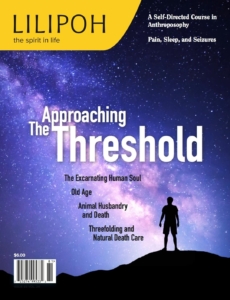Talking our Children to “Deaf”
There are moments of wonder which leave us astonished in joy as we witness a young child coming into beinghood. With each new step, she progresses further in coming into connection with this new physical and social world. Satisfying the infant’s hunger and snuggling establish a physical connection with the mother. The first smile reaches out as a social recognition of the parents. Cooing and vocalizing during moments of interaction with care-givers allow connection to extend outward through sound. The baby may smile and wiggle and tremble in delight as she now also coos to show her growing outreach to those who love and care for her. And perhaps nothing evokes quite as much excitement as when the first words sounded as speech come to birth.
To develop speech, the child must be in a community of speakers whom the young one can imitate. The little one hears speech, perceives and copies the sounds, gestures, and soul mood of the other speaker, and awaits response. Though this cooperative “dance” of sound, there develops a new connection of give and take between the partners that lives in time and overcomes space and physical separation. The little child listens to every word with devotion and receives it as a new, precious, holy possession.
Other animal species have forms of communication, but only human beings have speech. Gaining uprightness and walking as great deeds precede moving into speech. The child hears other people form sounds into speech and living language, and takes up his side of the dialogue. This capacity for speaking leads into thinking, which is viewed as the supreme capacity of our human race. In times long past, words were understood to hold wisdom and even mystery embedded within them. Speech was considered with reverence. Orators of ancient Greece worked tirelessly to sound-sculpt thoughts in carefully chosen words, sensitively expressed. Listeners could live into the intention within the speech, knowing that what was being spoken was something worth listening to.
Times have changed. All of us, adults and children as well, are surrounded by endless noises, sounds, and word chatter of all kinds. In a bombardment of busy sounds and aimless talk, we cannot figure out where to listen. Rudolf Steiner, the founder of Waldorf education, described little children as being “total sense organs.” They take in all stimulation equally without discrimination, and cannot defend themselves from what comes toward them. Yet all of our senses need rest. We can close our eyes, but we cannot close our ears. So what do little children do?
As we grow and become more practiced listeners, we develop what is termed “figure ground.” This means that when there are multiple streams of competing sound, we can choose to focus our attention on listening to what seems to be the most important. At home, that would be the parents’ voices guiding, directing, loving, and perhaps asking for something from the child. At school, it is the teacher’s voice guiding the lesson through his or her speech. It is assumed that what is being spoken to the child is worth listening to, and that the speaking is concise and clear both in articulation and in meaning. We know ourselves that there is a lot of verbiage in the world that is not worth listening to. So how do we help our children sort out this jumble?
Parents are commonly advised to speak a great deal—even excessively—to their children to stimulate language development. It is definitely important that parents speak and listen to their children as active models for imitation. But this well-intentioned advice has gone overboard. We can observe that we “over speak.” We repeat, emphasize, reason, explain our points to the degree that children stop their listening. They cannot tell whether the point is still to come or was made so long ago that they have lost track of what the subject was. So they stop listening.
The title of this article was not a misprint. Indeed, we are talking our children to “deaf.” It could be that this selective “deafness” is a sensory defense. Too many words muddle the brain and overwhelm the capacity for listening. "Over-speaking” and “over-explaining” can cause overwhelm. Children tune off and tune out.
If any of this seems familiar, we—parents, teachers, all others who nurture children—will do well to observe how we use our own speech. Of course, we need to have general conversation and chit-chat in informal ways. We do not want to over-do silence. Yet do we say what is important as a statement and then stop? Do we resist restating or explaining to make sure the child heard? Do we speak with warm attention and intention toward the listener? Do we find ourselves talking through our thinking processes when the listener is too young to sort out the essential from our “thinking out loud?”
Speaking shares information, gives direction, and makes connection from person to person by creating a bridge of sound through space. But most importantly, speech should convey meaning that is worth listening to. Speech, accompanied by gesture and gaze, creates connection from soul to soul. When it is meaning-filled, it reassures children that the speech of another is worth listening to. Linked with the example of purposeful deeds, children experience meaning and goodness through the careful, thoughtful speech of their parents and teachers—not too much, and not too little. Then we are not talking them to “deaf.” Our actions and speech are talking the children into good, human life.

